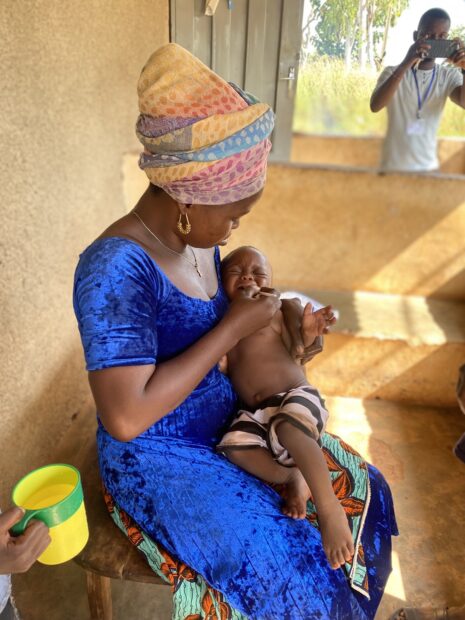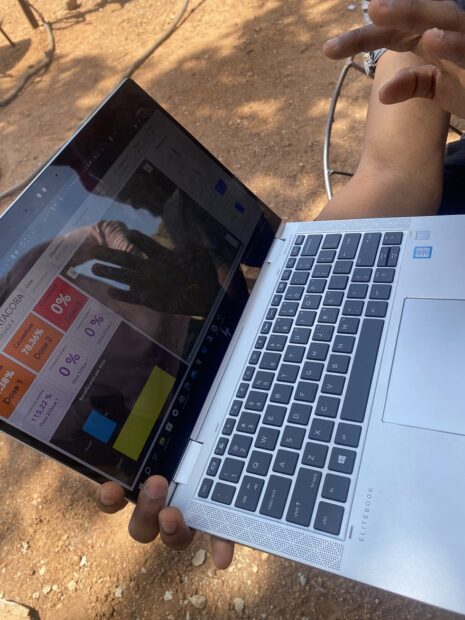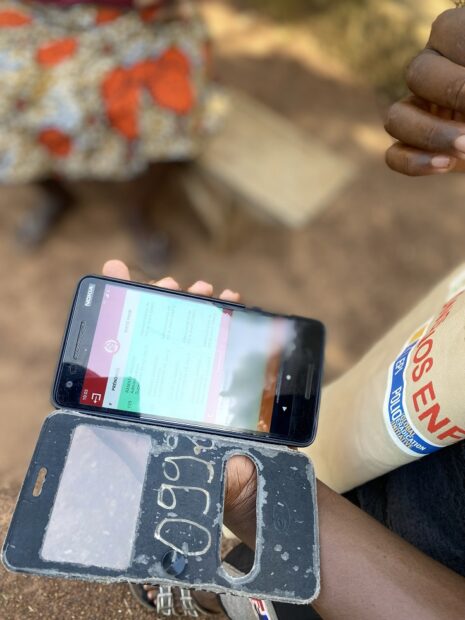Recent coverage increases in Benin are encouraging
Malaria remains a public health problem in Benin, with an estimated five million cases and over 11,100 deaths in 2021. Consequently, the government uses mass drug campaigns to provide antimalarial treatment to the most vulnerable people, including children. The government also distributes long-lasting insecticide-treated bed nets to homes to help prevent malaria.

Children under 5 are at higher risk than other age groups for severe malaria, which is often characterized by organ failure or other serious clinical outcomes. However, epidemiological studies have shown that treating children living in highly malarious areas with antimalarial drugs can prevent severe malaria. This treatment — seasonal malaria chemoprevention (SMC) —should happen before the rainy season when cases typically peak.
Challenges with paper-based campaigns
The Ministry of Health in Benin has implemented SMC campaigns since 2019. However, it has been challenging. The Ministry relied on paper-based campaign management, leading to gaps in data collected. Delays in data reporting affected critical decisions on campaign operations to reach the most children.
Digitizing chemoprevention campaigns can substantially reduce inefficiencies in the process. It can reduce the burden on staff and help health workers better track untreated and under-treated children. More importantly, digitization can help the government more quickly and accurately direct campaign resources to the highest-need geographies to improve coverage.

Digitizing seasonal malaria chemoprevention campaigns
In 2023, CHAI partnered with Benin’s Ministry of Health, notably, the National Malaria Control Program (NMCP), and Information Systems Department (DSI), as well as the World Health Organization, in digitizing its malaria mass drug campaigns. This digitization builds upon the substantial work of partners such as Catholic Relief Services. The fully digitized campaigns will provide health facilities with actionable data in real-time to increase coverage.
‘’ We felt the willingness to pass on skills from the partner [CHAI]. This kind of partnership must be strongly supported and encouraged, compared to other support in which government’s actors are not truly empowered, as in keeping them in a perpetual state of dependence.’’ said the Head Doctor of Banikoara Health District.

CHAI’s approach
CHAI’s contribution to the 2023 SMC campaign digitization in three areas:
1. Guiding digital malaria mass drug campaigns
CHAI worked with Benin’s DSI to provide real-time campaign monitoring. We used Geographic Information System (GIS)-based dashboards that enabled health workers to visualize coverage.
Health workers cannot reach every drug distributor to provide physical supervision. Therefore, they used the dashboards to provide a user-friendly way to target supervision. In addition, campaign supervisors used the dashboards to ensure no areas were left behind.
The dashboards provided more than just coverage visualizations. Supervisors could identify field malpractices such as fictitious drug administration and instantly alert the agents to correct their actions.
2. Identifying children for mass drug campaigns
In 2023, we began identifying children with an automated unique code. This seemingly minor improvement was a game-changer for data quality and, in turn, coverage rates. Previously, children eligible for seasonal malaria drugs were identified by names or a parent’s phone number and geographic coordinates. However, the practice often resulted in errors and inaccurate data, particularly when children had similar names or parents’ numbers mistyped. This resulted in failed follow-up treatments for children who had not completed the full four rounds or were missing treatment completely. With unique codes for each child, health workers made fewer mistakes and duplications. In addition, the right children were identified and targeted, even when a child had lost their identification card. With the unique identification, the NMCP now has more accurate data on the number of children that have completed the full treatment over four rounds of the campaign.
‘’ This is the first time we had such level of data analysis, and we can see it eased the validation of these data sets.’’ Head of statistics, Banikoara Health Zone, Northern Benin.
3. Training Ministry of Health actors to run digitized malaria mass drug campaigns independently
CHAI trained NMCP, DSI, and health workers to run campaigns autonomously to ensure government ownership. We facilitated the setup of a mixed coordination team where NMCP and DSI staff at central and local levels planned and managed SMC campaign digitization efforts.
The results
Nearly 70 percent (68.45%) of the targeted children received full treatment during the campaign. These are children identified during the first round who were followed to the fourth round of treatment, receiving all 12 doses. This milestone signified an improvement from the 2021 and 2022 campaigns, which both achieved 52 percent.
The quality of supervision has also improved thanks to integrating the dashboard with ArGIS, providing alerts against malpractices. In addition, coverage has extended to previously non-covered areas.
For 2024 and beyond, the Ministry of Health and its partners intend to leverage the gains of digitization to achieve the WHO target of 95 SMC coverage. In the future, the Ministry plans to use the lessons learned from the SMC campaign digitization to digitize malaria epidemiological surveillance and other public health campaigns.





